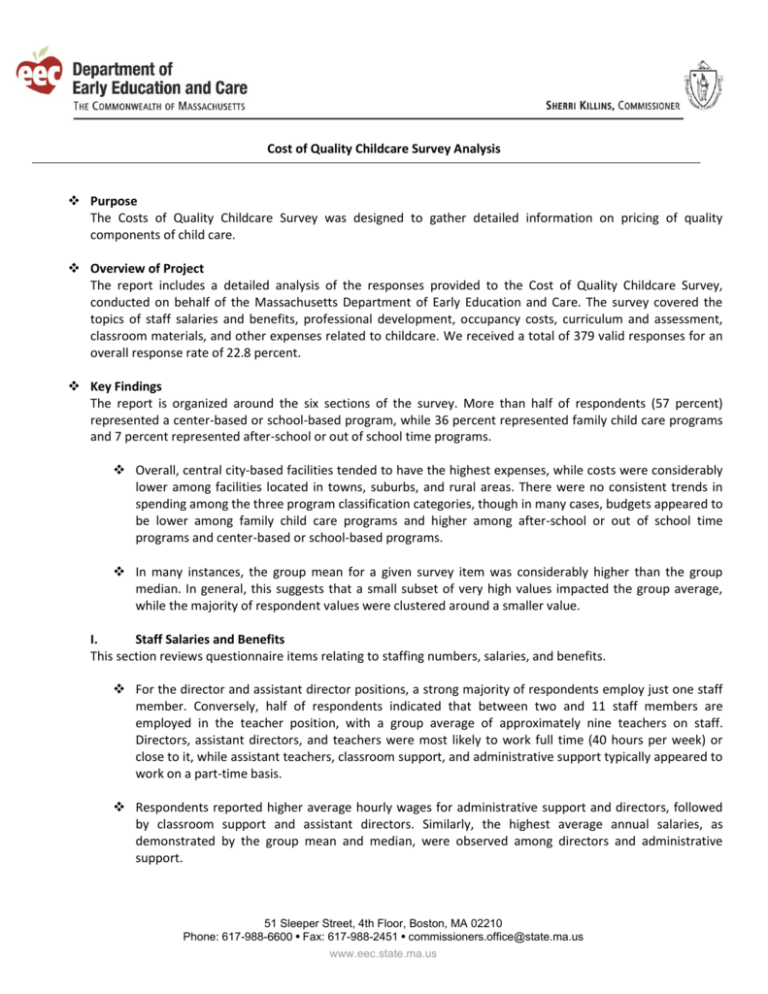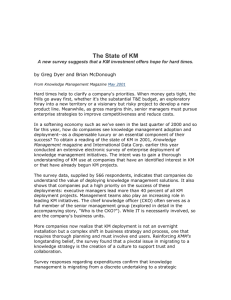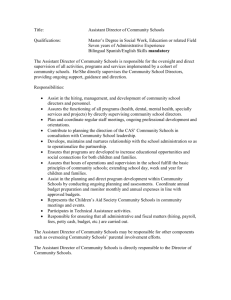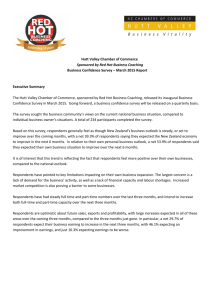Cost of Quality Childcare Survey Analysis Purpose The
advertisement

Cost of Quality Childcare Survey Analysis Purpose The Costs of Quality Childcare Survey was designed to gather detailed information on pricing of quality components of child care. Overview of Project The report includes a detailed analysis of the responses provided to the Cost of Quality Childcare Survey, conducted on behalf of the Massachusetts Department of Early Education and Care. The survey covered the topics of staff salaries and benefits, professional development, occupancy costs, curriculum and assessment, classroom materials, and other expenses related to childcare. We received a total of 379 valid responses for an overall response rate of 22.8 percent. Key Findings The report is organized around the six sections of the survey. More than half of respondents (57 percent) represented a center-based or school-based program, while 36 percent represented family child care programs and 7 percent represented after-school or out of school time programs. Overall, central city-based facilities tended to have the highest expenses, while costs were considerably lower among facilities located in towns, suburbs, and rural areas. There were no consistent trends in spending among the three program classification categories, though in many cases, budgets appeared to be lower among family child care programs and higher among after-school or out of school time programs and center-based or school-based programs. In many instances, the group mean for a given survey item was considerably higher than the group median. In general, this suggests that a small subset of very high values impacted the group average, while the majority of respondent values were clustered around a smaller value. I. Staff Salaries and Benefits This section reviews questionnaire items relating to staffing numbers, salaries, and benefits. For the director and assistant director positions, a strong majority of respondents employ just one staff member. Conversely, half of respondents indicated that between two and 11 staff members are employed in the teacher position, with a group average of approximately nine teachers on staff. Directors, assistant directors, and teachers were most likely to work full time (40 hours per week) or close to it, while assistant teachers, classroom support, and administrative support typically appeared to work on a part-time basis. Respondents reported higher average hourly wages for administrative support and directors, followed by classroom support and assistant directors. Similarly, the highest average annual salaries, as demonstrated by the group mean and median, were observed among directors and administrative support. 51 Sleeper Street, 4th Floor, Boston, MA 02210 Phone: 617-988-6600 • Fax: 617-988-2451 • commissioners.office@state.ma.us www.eec.state.ma.us Responses varied for the average number of days substitutes were used: the group median was 20, while the group average was 54. Conversely, over half of respondents indicated that the average cost of a substitute for one day of work was between $50 and $96, with a group median and mean of $72 and $78, respectively. Teachers and directors were the most likely to receive all three types of benefits (healthcare, unemployment insurance, and fringe), and healthcare benefits tended to be the most common benefits received across the board. The highest average amounts were spent on healthcare benefits for teachers, fringe benefits for classroom support, and fringe benefits for teachers. Overall, unemployment insurance benefits had the lowest average annual amounts across all position categories. II. Professional Development This section provides a discussion of questionnaire items pertaining to professional development, including courses and programs, materials, and release time. Teachers and directors were the most likely to benefit from spending on professional development courses and/or programs. The group means are considerably higher than the group medians, suggesting that there were several high values provided. Overall, spending on professional development courses and/or programs appears to be highest for classroom support staff and teachers. Teachers and directors were also the most likely to benefit from spending on professional development materials. On average, teachers received the highest average amounts of spending on professional development materials, while the values were generally comparable across the other four direct service positions. Of the five additional spending categories related to professional development, the most common type of professional development for which spending was reported was “professional development for licensing requirements,” while the highest group mean was for “college-level courses.” When asked to indicate how much their facility spends each year on instructors hired to teach professional development courses, half of the 114 respondents who answered this question provided a response of between $300 and $1,875, with a group mean of $2,393. When asked how much their facility spends each year on staffing costs associated with covering staff who are participating in professional development courses or programs, half of the 97 respondents reported spending between $300 and $2,000 for these staffing costs, with a group mean of $1,819. When asked to report how many hours are available in professional development release time each year for direct service staff, all positions received roughly similar amounts of release time, with classroom support staff and teachers receiving a few more days for professional development, on average III. Occupancy Costs This section reviews the responses provided to questions pertaining to occupancy costs of child care facilities. When asked to indicate the quality of their space based on the following classifications provided by the Building Owners and Managers Association, nearly two-thirds of respondents (63.9 percent) identified with Class B, while 20.2 percent and 16 percent of respondents selected Class A and Class C, respectively. In describing the geographic location of their facility, the most common response was “town” (42.9 percent of respondents), followed by “central city” at 29.1 percent. 2 Over half of respondents (59.1 percent) indicated that they own their property, while 23.3 percent and 17.6 percent of respondents lease or rent their facility, respectively. Lessees and renters had higher mean values for utilities than owners, at $18,547 and $17,884 in annual costs, respectively. Renters had the highest mean value ($4,878) for spending on classroom play spaces or environments, while owners had the lowest mean value ($2,983). The most common item (23.3 percent of respondents) to be subsidized or donated to lessees was repair, renovation, and maintenance services. Conversely, rent and repair, renovation, and maintenance services were subsidized or donated to nearly one-fifth of renters. IV. Curriculum and Assessment This section reviews questions relating to curriculum and assessment, including monetary costs and hours dedicated to planning and test administration. Typical spending was considerably higher for curriculum materials than for assessment tools, and the group mean for curriculum materials was more than double the group mean for assessment tools ($4,502 compared to $1,996). Directors, assistant directors, and teachers all dedicate approximately the same amount of time to curriculum preparation (average of around eight hours each week) while assistant teachers devote an average of 5.3 hours each week. When asked to report how many hours direct service staff members devote each week to administering and scoring student assessments, the mean value for assistant directors was highest at 5.3 hours each week, followed by teachers (5.1 hours) and directors (4.8 hours). V. Classroom Materials This section reviews responses to a series of questions on the costs of various types of classroom materials. When asked to report how much their facility spends each year on several types of classroom expenses, art materials received the highest group mean spending amount ($1,288), followed by materials to support language and literacy ($932) and materials for gross motor development ($848). Interestingly, the group medians for all classroom expenses (excluding art materials) were between $173 and $250, indicating that the middle ranges of values for all expenses were somewhat similar. When asked to indicate the percentage of the classroom materials from the previous question that were purchased used or second-hand, over half of respondents purchased less than 10 percent of these classroom materials second-hand or used. Childcare providers that purchased more than 75 percent of these items second-hand or used constituted just 6 percent of the sample. Among the three materials related to personal care routines, annual spending on cots and bedding typically ranged from $100 to $500, with a group average of $891, making it the least costly material related to personal care routines. Toileting and diapering was the most expensive, with half of respondents indicating that their facility spent between $150 and $1,000, and a group average of $1,563. The most costly food-related expense appeared to be for staff to provide food, which had a group average of $20,323. Although just 65 respondents indicated that this expense was applicable, half of those respondents reported paying between $2,000 and $20,462. Snacks were the least costly foodrelated expense, which cost half of respondents between $1,000 and $5,000 and had a group average of $4,950. 3 A total of 148 respondents indicated that they receive a food allowance from the Child and Adult Care Food Program (CACFP), which amounts to 56 percent of respondents who answered this question. This amount typically ranged from $300 to $23,250, and the group average of $26,749 suggests that there were several facilities receiving very large amounts from CACFP. Although budgets for office supplies appeared to be somewhat higher than the three types of computerrelated expenses overall (based on the upper boundary of the mid-50 percent of responses), the group average for IT support ($20,093) is by far the highest of the four, most likely because of several facilities budgeting very large amounts of funding for this expense. Over half of respondents employ a janitor or contract with a janitorial service (132 versus 129). Facilities that use a janitor or janitorial service budget a considerably higher amount for these services (mean of $18,339) than facilities without janitorial services spend on cleaning supplies (mean of $841). Among facilities that do not employ a janitor or contract with a janitorial service, directors and teachers were most likely to perform any cleaning-related duties. Interestingly, all four direct service positions typically spent the same amount of time performing these duties: across all job categories, the middle-50 percent of responses were in approximately the same range. The group means, however, indicated that teachers and directors may have spent more time performing cleaning-related duties (means of 209 and 236 hours, respectively, versus 183 hours for assistant teachers and 151 hours for assistant directors). VI. Other Expenses The final section asked respondents about spending patterns for various other expenses, including parent outreach and involvement. Among seven miscellaneous expenses, the widest middle 50-percent ranges of values were provided for transportation and administrative office supports, and the highest group means were for administrative office supports, transportation, and licensing fees. Of the four types of spending related to parent outreach and involvement, the highest group median value was for parent nights ($400), while the highest group mean was for home visits ($3,300). 4









